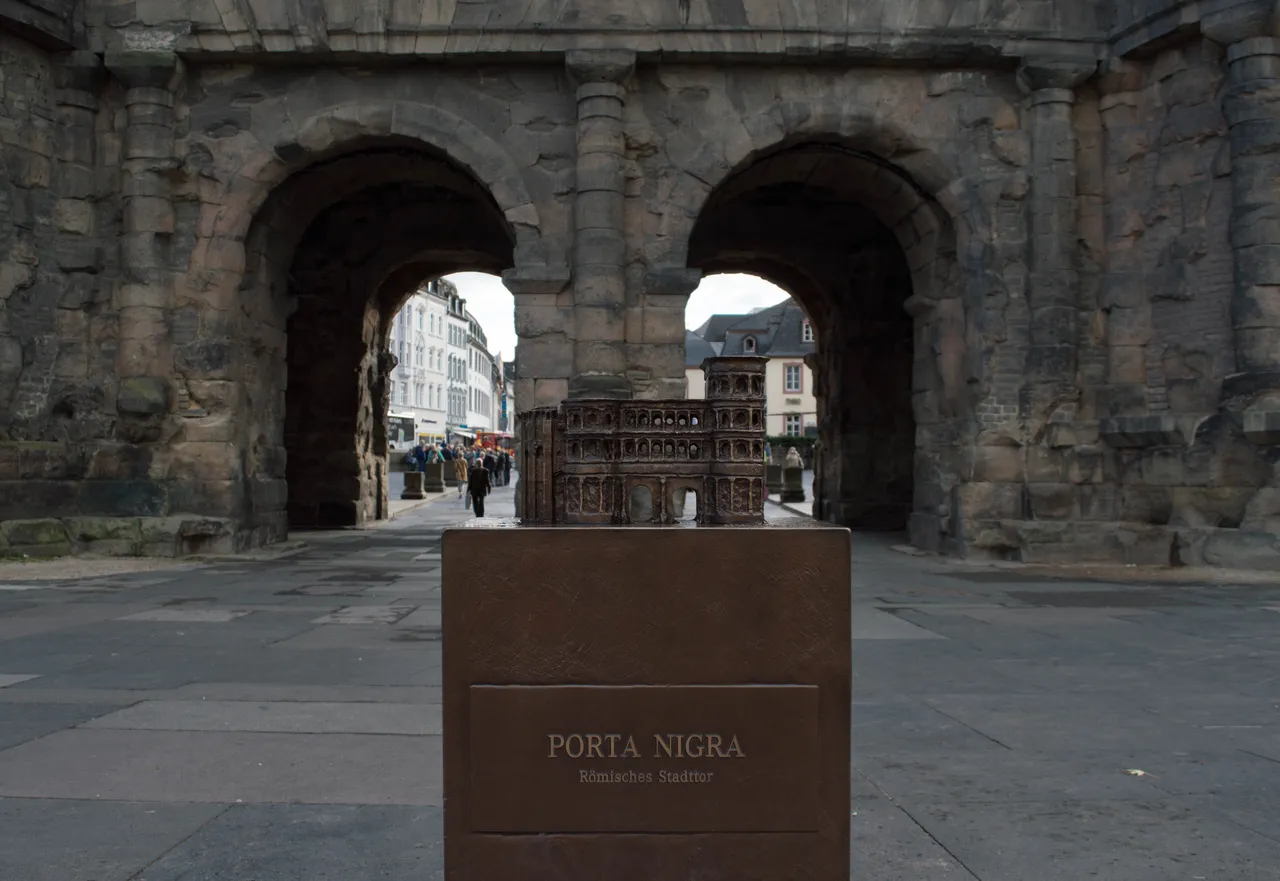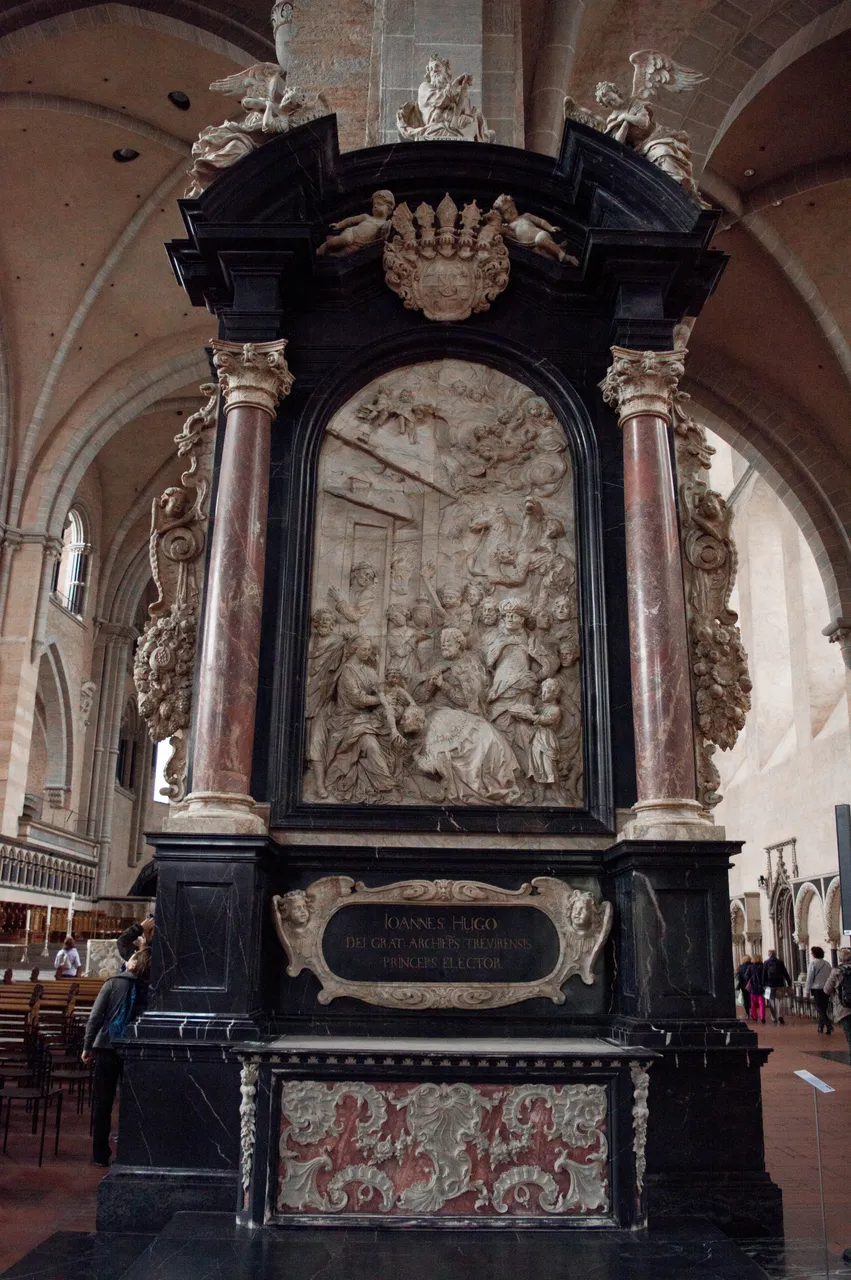Have you ever been to Trier in Germany? I was planning to go there for a long time and I finally had a chance to visit this charming city for one day last week..
Trier is a city in southwestern Germany, near the border with Luxembourg. The city dates back to 17 BC and it is the oldest city in Germany. The founding date is estimated from the age of the wooden pilings of the first Moselle bridge found in the mud of the river Moselle.
One day in Trier is not enough (especially when it's raining for a several hours in the afternoon), so let's start the tour so that we manage to see as much as possible!

ISO 100 1/125 sec. f/7.1 18 mm

Porta Nigra
The Porta Nigra ('Black Gate') is the most famous building in Trier and has become its symbol. It dates back to the 2nd century. It was built during the time of Marcus Aurelius and 7200 blocks of stone were used for its construction. It was supposed to be built with two towers, but for an unknown reason the second tower was never built.

ISO 100 1/160 sec. f/7.1 22 mm
It was part of the city wall and it assumed that the main purpose of the Porta Nigra was to impress visitors as it was built during the peaceful times. The windows in the gate were built to place catapults. Even though there was no danger during that time, people didn't know when the city will be attacked, and this is the reason why these windows were included in the construction of the gate.

ISO 100 1/125 sec. f/6.3 18 mm
The Porta Nigra had to defend the city on many occasions. In the 11th century it served as home for the monk Simeon, who lived there as a hermit. On his death the city gate was converted into a church, which was of the reasons of its survival. There were many renovations of the gate over the centuries. In 1803 under Napoleon's rule the church was dissolved, and orders were given to restore its ancient design.
The Porta Nigra is included on the UNESCO World Cultural Heritage list.

ISO 100 1/160 sec. f/7.1 18 mm
Let's go to the Hauptmarkt (Main Market Square) now!

Hauptmarkt
The Hauptmarkt is the main square in Trier and it has been in this place since the 10th century when Archbishop Heinrich I moved the Market Cross from the river to its present site. Today, it is a lively square with many cafes, restaurant, and various markets.
Trier lies within the important Moselle wine region and there were many producers of local wine selling their grapes and bottles of wine. I have to disappoint you and say that I forgot to buy a bottle when I was there!

ISO 100 1/200 sec. f/6.3 18 mm
The Hauptmarks is dominated by the St. Gangolf church towering above the main square. The church tower dates back to the 14th century and the church was built in the 15th century.

ISO 100 1/160 sec. f/6.3 18 mm
The Petrusbronnen or Marktbrunnen (Petrus or Market Fountain) has been created by renaissance sculptor Hans Ruprecht Hoffmann in the 16th century.

The Market Fountain shows St. Peter, the patron saint of the Cathedral as well as the city, standing on top, surrounded by the four cardinal virtues of good city government, Justice, Strength, Temperance, and Wisdom.
These are however replicas of the original statues that are kept in the city museum from 1976 to protect them from pollution.
The Main Market Square is very colorful and the fountain fits there perfectly with its rich golden decoration and detailed design.
Have you noticed that this photo has clear sky unlike other photos? I came to the city center twice. It was cloudy and very cold in the morning. It was also very crowded, so I decided to come back later in the afternoon. And I was lucky! It stopped raining in the afternoon and the sky was clear, so I walked around the square again 😊
Our next stop will be the Cathedral!

Trier Cathedral
Trier has been the seat of a bishop since he second half of the 3rd centuryt and it is the older bishop's church in Germany. Trier Cathedral together with the adjacent Church of Our Lady was included on the list of UNESCO World Cultural Heritage in 1986.

ISO 100 1/160 sec. f/6.3 18 mm
This is the Church of Our Lady that is built on the right side of the Cathedral. It looks very impressive but inside it is very simple and not exactly what I expected. I was a little bit disappointed.


Among all the cathedrals north of the Alps, Trier Cathedral is the oldest one.

In the 3rd century there was a small church in the place where the Cathedral stands now. This church was expanded into a monumental structure in the 4th century. The Cathedral was heavily damaged in the 5th and 9th century. The extensive restoration work took place in the 19th and 20th century.
Do you know why such buildings are called 'Cathedrals'? The name 'Cathedral' for a bishop's church is derived from the bishop's seat in the church, called 'cathedra'.
The most precious relic of Trier Cathedral is the Holy Robe - the Tunic of Christ. Legend says that the Tunic was brought to Trier by the Emperor's mother Helena. In 1512, the high altar was opened in the presence of Holy Roman Emperor Maximilian, initiating the first pilgrimage to the Holy Robe.
Today, the Holy Robe has been kept behind the glass in the Holy Robe chapel that is not accessible to visitors.
Shall we go inside of the Cathedral?
The interior is rather simple, but the space is impressive anyway.

ISO 400 1/125 sec. f/4 18 mm
There are many altars and burial monuments in the Cathedral.
On the left we can see the Altar of the Three Magi and burial altar for Johann Hugo von Orsbeck.
On the right we can see the Cross Altar and the grave plate for Archbishop Richard von Greiffenklau.


The cloister was built in the 13th century. Let's walk around the cloister and transport ourselves back to the past!

ISO 100 1/125 sec. f/4.5 18 mm
It was already raining so I stayed inside. There were some people going outside and looking at the graves of former bishops and archbishop but I preferred to stay dry 😊

ISO 100 1/160 sec. f/8 18 mm
I couldn't find who created these sculptures of angels but I admire the way how the modern art fits into the old architecture.

ISO 100 1/100 sec. f/7.1 18 mm
You can enjoy beautiful views of the Trier Cathedral and the Church of Our Lady while walking around the cloister...


I think that now it's the right time to return back to the city..

Kurfürstliches Palais
The Kurfürstliches Palais (Electoral Palace) is considered one of the most beautiful rococo palaces in the world. The palace was built in the 17th century by Electoral Prince Lothar von Metternich, and the rococo facade of the building was commissioned by the Archbishop and elector of Trier Johann Philipp von Walderdorff in the 18th century.

ISO 100 1/160 sec. f/7.1 18 mm
The palace was badly damaged during the World War and it was later restored to its current appearance. Since 2000 it has been the seat of the Supervisory and Service Directorate (ADD).
In front of the palace there are beautiful gardens with statues that represent classical gods and mythological figures. Some of the are very bizarre if you ask me. Look at the statue on the right to understand what I mean..

ISO 100 1/160 sec. f/7.1 18 mm
There were still a few flowers blooming in the garden..

Samsung Galaxy S7

Samsung Galaxy S7


It was a very cold, windy day but I have enjoyed the tour of Trier. There are still so many places to see in this city but it is impossible to visit them all within one day.
I hope you have enjoyed this excursion of the oldest city in Germany. Standing in front of the Porta Nigra was an experience that I can't even describe with words.
You must experience it yourself to understand it, so make sure to put Trier on your travel list!
All pictures are taken by my Nikon D3200 AF-S NIKKOR 18-55 mm 1:3.5-5.6 G II (except of the ones indicated in the text)
Thank you for reading!
Cheers,
Martina

Join us @steemitbloggers
Animation By @zord189
